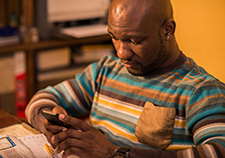Office of Research & Development |
 |

VA Research Currents archive
April 26, 2017
By Mike Richman
VA Research Communications

Veterans with chronic back pain who got behavioral therapy via an interactive phone system showed as much relief as those who got in-person therapy. (Photo for illustrative purposes only. ©iStock/BraunS)
A computer-based telephone system that allows one to respond with the phone's keypad to a recorded voice asking questions is nothing new. The system, known as interactive voice response (IVR), has long been used in healthcare and for everyday business transactions.
What about people with chronic pain?
VA researchers investigated cognitive behavioral therapy (CBT) delivered via interactive voice response for Veterans with chronic low back pain. Cognitive behavioral therapy is a short-term, low-risk psychotherapy that aims to change negative patterns of thinking or behavior that underlie people's difficulties, and to improve the way they feel, through methods such as relaxation techniques and pain-coping skills. It is effective in reducing pain and improving function for many complaints, including back discomfort and osteoarthritis.
"Ideally, Veterans will be able to choose the method they prefer, and one that is most convenient for them."
The study, published in April 2017 in JAMA Internal Medicine, included 125 Veterans in treatment for chronic low back pain at the VA Connecticut Healthcare System. It compared 62 patients who received IVR-CBT with 63 patients who received in-person CBT. There was no distinct advantage for either treatment. Participants in both groups showed major reductions in average pain intensity at three and six months past baseline, but not at nine.
Each group also demonstrated significant improvements in physical functioning (how much the pain interfered with everyday activities), in physical quality of life (how much physical problems in general, not just pain, limited activities and functioning), and in sleep quality.
The researchers thus concluded that "IVR-CBT is a low-burden alternative that can increase access to CBT for chronic pain and [that] shows promise as a nonpharmacologic treatment option for chronic pain, with outcomes that are not inferior to in-person CBT."
Research has shown that cognitive behavioral therapy can benefit Veterans and others with chronic pain. But patients can experience travel and scheduling problems in attending in-person sessions. Hence, lead author Dr. Alicia Heapy and her team set out to learn if an IVR-assisted delivery method of CBT for chronic pain would improve access to care and produce positive results. That treatment's effectiveness compared to in-person CBT is relatively unknown.

Heapy, a clinical psychologist at the VA Connecticut Healthcare System, says she expected the in-person CBT to lead to better results than the IVR-CBT but did not know how much better.
"In the trial, we saw that participants in the IVR-CBT treatment [participated in] more weeks of treatment on average, most likely because the treatment was more convenient," she says. "The higher dose of treatment was likely at least part of the reason that participants in IVT-CBT did almost as well as those in in-person CBT."
Heapy says she and her team are looking at IVR-CBT as an alternative to in-person CBT, not necessarily as a replacement. Their goal is simply to give Veterans more options to address chronic pain through cognitive behavioral therapy, she notes.
"Ideally, Veterans will be able to choose the method they prefer, and one that is most convenient for them," she says.
The study marked the first known trial of CBT for chronic pain using IVR as the sole means of delivery. Joint and back pain and other musculoskeletal ailments are the most common diagnoses among Iraq and Afghanistan Veterans.
The 125 participants were randomly chosen for IVR-CBT or in-person CBT for 10 weeks of treatment. They had reported chronic low back pain of at least three months and at least a moderate level of pain. The average age of the Veterans in the study was around 60. Most of them were male and white.
Veterans in the IVR-CBT group participated from their homes. Those receiving in-person CBT came to the VA for a weekly appointment with a therapist.
All participants received a daily automated IVR call with questions about their pain level, sleep duration, and pedometer-measured step counts in a progressive walking program, and about whether they were practicing the pain-coping skills laid out for them in treatment handbooks. There were also questions related to catastrophizing, or irrational thoughts in believing something is far worse than it really is.
In addition to the daily call, Veterans in the IVR-CBT treatment received recorded explanations via telephone of items in the handbook that weren't provided to the in-house patients. They could also hear testimonials from other Veterans who had used CBT for back pain, and they could leave phone messages for therapists. Their treatment handbooks also contained much more information about how to practice the skills recommended for coping with back pain.
In one of the most advantageous parts of the therapy, the IVR-CBT patients used their phone keypad to answer the same daily questions. They were asked, for example, to rate their average pain that day on a scale that assigned 0 for no pain and 10 for the worst pain imaginable. At the end of each week, Heapy says, a therapist reviewed all of the patients' answers for that time period and recorded a personalized feedback message based on the answers. She says the feedback changed according to the responses.
"The feedback was designed to provide praise for practicing skills and meeting goals," she says. "Feedback was also given about pain, sleep, and physical activity. Was it better, worse, or the same as prior weeks?"
Many of the IVR-CBT Veterans said their favorite part was the walking program, Heapy says. They received a pedometer and a goal for the number of steps to walk each day.
"People in the trial were also given a daily goal to practice the pain management skills they were learning," she says. "For example, they might be asked to do a muscle relaxation exercise for 10 minutes each day for a week."
In contrast, those who came to VA for their sessions received a much smaller manual. They obtained most of the information about pain-coping skills from their therapists, who reviewed the patients' IVR reports and provided feedback during their sessions.
Over the course of the treatment period, the IVR-CBT participants attended more treatment weeks than the in-person CBT Veterans, 8.9 versus 6.6.
The key measurement was the change at three months in patient reports of average pain reduction, according to the rating scale used in the study. The reduction was .77 for IVR-CBT and .84 for in-person CBT at three months; 1.23 for IVR-CBT and 1.00 for in-person CBT at six months; and .51 for IVT-CBT and .44 for in-person CBT at nine months.
A lot of the IVR-CBT participants provided positive feedback about the technology.
"Many people told us they really liked the daily automated phone calls because they could report how they were doing, and they felt a sense of accomplishment to be able to say they met their goals," she says. "Some also said it helped them stay on track to know they would be reporting how they were doing every day. They said it helped them to make a promise and to set a goal with someone else who could help them be accountable."
To learn more about the feasibility of IVR-CBT, Heapy says she is working on a trial in which the technology is made available to community-based outpatient clinics (CBOCs) associated with the VA medical centers in Boston, Indianapolis, and Palo Alto, California. She says researchers targeted CBOCs—many of which are in outlying, rural areas—because Veterans who use such facilities have less access to CBT for chronic pain. She assumes that in-person CBT is more costly than IVR-CBT because it involves a greater time commitment from therapists, but she isn't sure how much more expensive it may be.
"We hope this study will help us learn if IVR-CBT can be used more widely," she says. "We also want to find out the best way to get people who can benefit from the technology to use it."
Heapy also hopes the IVR-CBT program will someday be implemented throughout the VA healthcare system. "We are actively trying to build partnerships within VA that will allow us to expand the program," she says.